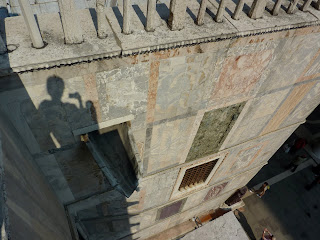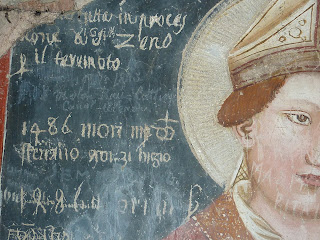Opera Cleveland: Pagliacci & Voix Humaine at the State Theater (November 13)
by Nicholas Jones
 At the end of Pagliacci, we hear the chilling line “La commedia è finita” – the play is over. So, sadly, is the opera: with this weekend’s double bill, Opera Cleveland — at least in its present form — goes into a period of hiatus for re-structuring and re-imagining.
At the end of Pagliacci, we hear the chilling line “La commedia è finita” – the play is over. So, sadly, is the opera: with this weekend’s double bill, Opera Cleveland — at least in its present form — goes into a period of hiatus for re-structuring and re-imagining.
Somber in tone and tragic in outcome, these two very different operas made an evening of passionate and memorable celebration of the artistic success that Opera Cleveland has achieved in recent years.
The evening opened with Francis Poulenc’s one-act opera, La Voix Humaine. The libretto comes from a pre-war play by avant-garde poet Jean Cocteau. The premise is deceptively simple: a Parisian woman speaks on the telephone with her former lover for almost three-quarters of an hour. The situation, though, is complicated: we struggle to sort out her complex mixture of lies, self-deceptions and manipulations, even while we sympathize with her pain. She’s barely hanging on, literally by a cord, the single telephone cord that connects her with her ex — at least, at times (the post-war phone system in Paris was notoriously unreliable, so the call is interrupted often).
Poulenc’s strange opera draws its appeal from an age-old truth: we enjoy watching the display of suffering. I kept thinking back to the great lament of Dido in Purcell’s opera of some 300 years earlier: “Remember me, but, ah! forget my fate.” Like Dido, Poulenc’s nameless Parisienne expresses her sorrow with a mixture of foolishness and dignity, and we listen in with guilty pleasure. Dido had no telephone, but modern technology solves none of the tragedies of desire.
Soprano Robin Follman carried the role with extraordinary skill. Dramatically focused, she wove across the stage (a stylish thirties set with beige and brown toned furniture) with an old bakelite telephone; her gestures were economical and full of powerful expression. Above all, she gave us Poulenc’s thorny musical lines with a variety of coloration and tonality that brought to musical life the vagaries of this tortured conversation.
The other protagonist was the orchestra, masterfully led by Dean Williamson. Among many wonderful moments, I’d note the glockenspiel as the ironic ring of the telephone (promising connectivity, but rarely delivering) and the chilling ending with a dry cymbal roll followed by a terribly mordant pluck on the double basses (who played an unusually dramatic role in the entire opera). Unfortunately, an epidemic of coughing in the audience (nervous? bored?) plagued the performance.
After intermission Opera Cleveland gave us a passionate Pagliacci, radically separated from its usual partnering with Cavalleria Rusticana (“Cav and Pag”). In my ear, the modernist opening to the evening made the blatant emotionalism of “Pag” even more engaging. The production focused, rightly, on the heartfelt music (though I could have done without a couple of superfluous and unscripted mimes in the prologue and at the end). A tight 90-minute drama in the verismo style, Pagliacci delivers a powerful punch to the emotions: desire, jealousy, bitterness, revenge.
Especially powerful was tenor Gregory Carroll as Canio — the tormented clown whose great aria (“Vesti la gubbio” – better known as “Ridi, Pagliacco”) has been for a century an icon of tragically dissonant emotion. Against him — in many ways — was Robin Follman’s Nedda, the wife whose fidelity Canio rightly suspects. Coming off her Poulenc performance, Follman hardly seemed to need intermission to change modes: her Nedda was brilliantly mercurial — by turns lyrical, taunting, uncertain, furious. She showed once again that what makes for operatic impact is the ability to change color on a dime, to play the moment to the max.
Nedda’s lover, Sylvio, sung by Eric Dubin, lacked the flexibility and nuance to match Follman’s vitality. His portrayal was undercut by an absurd directorial choice to have the illicit lovers suddenly lie down to embrace on the stones of the piazza (in public in Italy?). The embittered Tonio, who lusts for Nedda and betrays her to her jealous husband, was chillingly sung by Michael Chioldi.
In the indeterminate interim before we hear another Opera Cleveland production, I hope that the artistic leadership and the board find ways to maintain the elements of their success — generally fine lead singers, a top-notch chorus, an excellent orchestra, and stimulating productions — while finding new approaches to meet the problems of financial stability. While of course large audiences are crucial for many reasons, I would suggest that a somewhat smaller and more acoustically friendly venue than the cavernous State Theater might be a part of the future.
Photograph: Eric Mull
by Nicholas Jones
 At the end of Pagliacci, we hear the chilling line “La commedia è finita” – the play is over. So, sadly, is the opera: with this weekend’s double bill, Opera Cleveland — at least in its present form — goes into a period of hiatus for re-structuring and re-imagining.
At the end of Pagliacci, we hear the chilling line “La commedia è finita” – the play is over. So, sadly, is the opera: with this weekend’s double bill, Opera Cleveland — at least in its present form — goes into a period of hiatus for re-structuring and re-imagining.Somber in tone and tragic in outcome, these two very different operas made an evening of passionate and memorable celebration of the artistic success that Opera Cleveland has achieved in recent years.
The evening opened with Francis Poulenc’s one-act opera, La Voix Humaine. The libretto comes from a pre-war play by avant-garde poet Jean Cocteau. The premise is deceptively simple: a Parisian woman speaks on the telephone with her former lover for almost three-quarters of an hour. The situation, though, is complicated: we struggle to sort out her complex mixture of lies, self-deceptions and manipulations, even while we sympathize with her pain. She’s barely hanging on, literally by a cord, the single telephone cord that connects her with her ex — at least, at times (the post-war phone system in Paris was notoriously unreliable, so the call is interrupted often).
Poulenc’s strange opera draws its appeal from an age-old truth: we enjoy watching the display of suffering. I kept thinking back to the great lament of Dido in Purcell’s opera of some 300 years earlier: “Remember me, but, ah! forget my fate.” Like Dido, Poulenc’s nameless Parisienne expresses her sorrow with a mixture of foolishness and dignity, and we listen in with guilty pleasure. Dido had no telephone, but modern technology solves none of the tragedies of desire.
Soprano Robin Follman carried the role with extraordinary skill. Dramatically focused, she wove across the stage (a stylish thirties set with beige and brown toned furniture) with an old bakelite telephone; her gestures were economical and full of powerful expression. Above all, she gave us Poulenc’s thorny musical lines with a variety of coloration and tonality that brought to musical life the vagaries of this tortured conversation.
The other protagonist was the orchestra, masterfully led by Dean Williamson. Among many wonderful moments, I’d note the glockenspiel as the ironic ring of the telephone (promising connectivity, but rarely delivering) and the chilling ending with a dry cymbal roll followed by a terribly mordant pluck on the double basses (who played an unusually dramatic role in the entire opera). Unfortunately, an epidemic of coughing in the audience (nervous? bored?) plagued the performance.
After intermission Opera Cleveland gave us a passionate Pagliacci, radically separated from its usual partnering with Cavalleria Rusticana (“Cav and Pag”). In my ear, the modernist opening to the evening made the blatant emotionalism of “Pag” even more engaging. The production focused, rightly, on the heartfelt music (though I could have done without a couple of superfluous and unscripted mimes in the prologue and at the end). A tight 90-minute drama in the verismo style, Pagliacci delivers a powerful punch to the emotions: desire, jealousy, bitterness, revenge.
Especially powerful was tenor Gregory Carroll as Canio — the tormented clown whose great aria (“Vesti la gubbio” – better known as “Ridi, Pagliacco”) has been for a century an icon of tragically dissonant emotion. Against him — in many ways — was Robin Follman’s Nedda, the wife whose fidelity Canio rightly suspects. Coming off her Poulenc performance, Follman hardly seemed to need intermission to change modes: her Nedda was brilliantly mercurial — by turns lyrical, taunting, uncertain, furious. She showed once again that what makes for operatic impact is the ability to change color on a dime, to play the moment to the max.
Nedda’s lover, Sylvio, sung by Eric Dubin, lacked the flexibility and nuance to match Follman’s vitality. His portrayal was undercut by an absurd directorial choice to have the illicit lovers suddenly lie down to embrace on the stones of the piazza (in public in Italy?). The embittered Tonio, who lusts for Nedda and betrays her to her jealous husband, was chillingly sung by Michael Chioldi.
In the indeterminate interim before we hear another Opera Cleveland production, I hope that the artistic leadership and the board find ways to maintain the elements of their success — generally fine lead singers, a top-notch chorus, an excellent orchestra, and stimulating productions — while finding new approaches to meet the problems of financial stability. While of course large audiences are crucial for many reasons, I would suggest that a somewhat smaller and more acoustically friendly venue than the cavernous State Theater might be a part of the future.
Photograph: Eric Mull















































